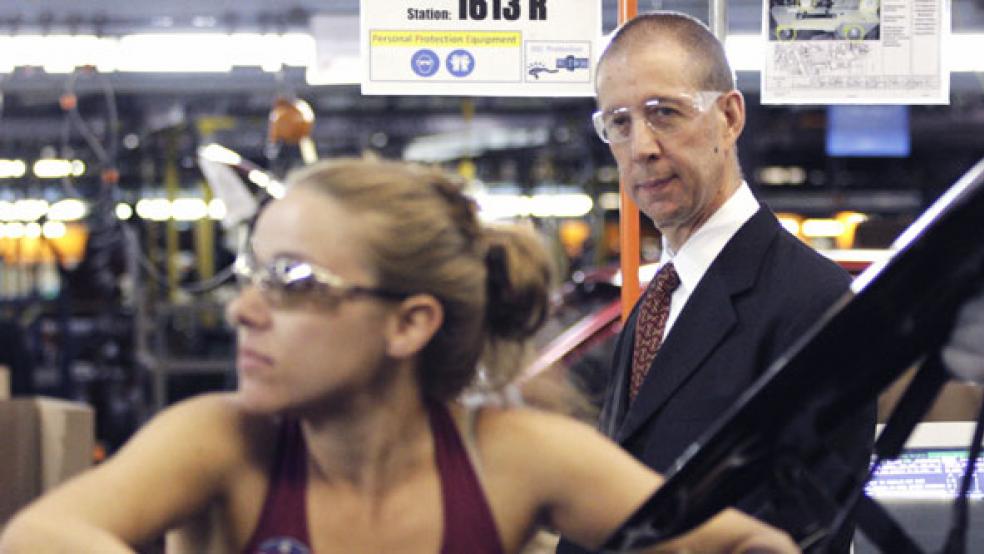|
Economists are on high alert for signs that the U.S. is slipping back into recession. Right now they have a laser-sharp focus on the business sector. Early-bird readings for August show that business confidence has taken a heavy blow from debt-ceiling brinkmanship, the U.S credit downgrade, and the stock market’s recent declines. Forecasters are lowering their sights on U.S. and European growth in the coming year, which threatens the outlook for profits. The risk is a sudden retrenchment by businesses. Soon after the stock market went south in both 2000 and 2008, so did both capital spending and payrolls.
Regional business surveys took a turn for the worse in August. The Empire State Manufacturing Index, compiled by the New York Federal Reserve Bank, and the Philadelphia Federal Reserve’s Business Conditions Index both showed significant weakening of manufacturing activity in early August. Survey data from the Richmond and Kansas City Fed districts showed similar downturns. National surveys of both manufacturing and nonmanufacturing activity, due Sept. 1 and Sept. 6, respectively, from the Institute for Supply Management will offer the first broad readings of August business conditions. Economists expect weaker readings, the question is how weak.
The erosion in business confidence began in the second quarter and picked up speed when the Commerce Dept.’s July 29 estimate of GDP showed a sharp loss of momentum in economic growth in the first half. With more complete data in hand, Commerce said on Friday that the economy grew only 1 percent last quarter, slightly less than the 1.3 percent pace first reported. Coupled with the first quarter’s 0.4 percent pace, growth in the first half averaged a mere 0.7 percent. One upbeat implication of the report was that overall spending was a shade stronger than first reported, while inventories did not pile up as fast, a favorable combination for a small pickup in the third quarter, as many economists expect.
Still, profits drive business expansion, and if the forecasters are right, earnings are sure to be under pressure in the coming year. The latest Blue Chip Economic Indicators survey of top economists forecasts an average gain of 1.8 percent in 2011 and 2.5 percent in 2012. That would be a tough business climate, compared with 3 percent earnings growth in 2010, but many big Wall Street firms are even more pessimistic. J.P Morgan is especially bearish, expecting only 1 percent growth over the next four quarters.
Regional surveys in August point to some pullback in plans for capital spending, along with broad weakening in overall new orders.
Until now, companies have been able to maintain solid earnings growth with keen attention to productivity gains and cost control, partly reflecting cautious hiring practices. The Commerce Dept.’s first look at second-quarter profits, released with the GDP report on Aug. 26, looked strong. This measure of profits is seasonally adjusted, allowing quarter-to-quarter comparisons, and it showed a rise 3 percent from the first quarter. That was the largest gain since the second quarter of 2010 and the tenth consecutive quarter-to-quarter increase. Commerce said earnings of nonfinancial corporations, up 10.6 percent from the first quarter, were particularly strong, and profit margins widened further.

Sturdy profits and cash flow have supported business outlays for equipment and other capital investments, but hiring has lagged. “For the recovery to become sustainable, the relatively strong position of the corporate sector needs to be translated into consistent strong gains in employment,” says Barclays Capital economist Peter Newland. That hasn’t happened, and any pullback from the current sluggish growth in employment would mean more trouble for consumer spending.
Investors and policymakers at the Federal Reserve will have a sharp eye on the Labor Dept.’s employment report for August on Sept. 2, as they gauge the business sector’s reaction to recent news and market events. Through Aug. 20, weekly claims for jobless benefits, which would offer the first hard signal that company layoffs are accelerating, continued their recent downtrend. Claims ticked up in the most recent two weeks reflecting the strike of 45,000 workers at Verizon, according to the Labor Dept. Adjusted for the strike effects, the claims in August are running 2.3 percent below the July level, a good sign for August payrolls.
Companies’ continued willingness to shell out money for more workers and new equipment will be tested in coming months. The updated GDP data showed continued solid increases in outlays for equipment and software of about 8 percent annually in the first and second quarters, and through July the trend in new orders for business equipment remained higher. However, regional surveys in August point to some pullback in plans for capital spending, along with broad weakening in overall new orders.

Some of that weakness reflects a turn to slower growth abroad, especially in Europe, in addition to weakness at home. European economists at Morgan Stanley have lowered their forecasts for eurozone growth, projecting 1.7 percent growth in 2011 and only 0.5 percent in 2012. Consumer spending in both Germany and France actually contracted during the second quarter. Exports have played a major role in U.S. business activity in the recovery, growing 7.2 percent over the past year, and profits from foreign operations have accounted 32 percent of the gain in U.S. corporate profits.
Businesses have made money the old fashioned way—by slashing costs.
One ray of hope is that recent worry in the business sector will not translate into a major retrenchment. Since the end of July, economists at UBS have noticed a clear split between survey data from companies, which tend to reflect sentiment as much as real activity, and more direct measures of /node/51813 consumer spending, job, and output. Weekly sales data from retailers in August do not show any sudden pullback by shoppers. The trend in jobless claims remains favorable, and auto production schedules are still on track for a solid contribution to industrial production.
But throughout this tepid recovery, caution has been the byword in Corporate America. Businesses have made money the old fashioned way—by slashing costs. Another round of cutbacks could stop the recovery cold.





